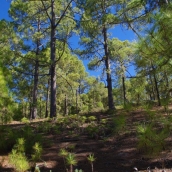Canary Island pine (Pinus canariensis)
Tree to 30-40 m, erect and highly branched. The bark is thick, grey-brown to reddish brown, depending on the age of the specimen. Leaves are needle-like, light green, up to 30 cm and in threes. The male flowers are arranged on short twigs in catkin-like clusters, while the female flower is a small strobilus or cone. Fruits (cones) up to 20 cm long and reddish-brown. This native of the Canary Islands grows naturally on the central (Gran Canaria and Tenerife) and western (La Gomera, La Palma and El Hierro) islands and has been introduced into Fuerteventura and Lanzarote. The most extensive and best preserved natural pine forests are located in Tamadaba and Inagua, in Gran Canaria; Aguamansa-Santa Úrsula, La Guancha-Icod, Arico, Vilaflor and Guía de Isora, in Tenerife; the Caldera de Taburiente, Tajadre and Garafía, in La Palma; and El Pinar in El Hierro. La Gomera only has small isolated populations growing on the phonolitic outcrops of Ojila and El Garabato. The Canary Island pine appeared in several areas of the Mediterranean basin in a relatively recent geological past, which is why it is considered a paleoendemism.













